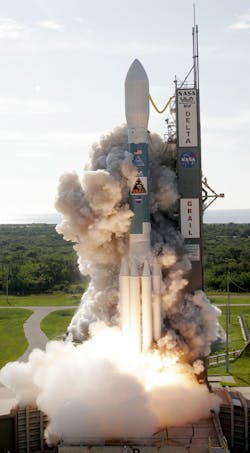DENVER, January 3, 2012. Both of NASA’s Gravity Recovery And Interior Laboratory (GRAIL) spacecraft were successfully inserted into orbit around the Earth’s moon. The mission will analyze the internal structure and gravitational forces of the moon. Lockheed Martin [NYSE: LMT] built the twin robotic spacecraft and is conducting flight operations for NASA’s Jet Propulsion Laboratory. The first orbiter, GRAIL-A fired its main engine on Dec. 31 at 2:21 p.m. MT. The 38-minute burn slowed the spacecraft down and was captured into orbit by the moon’s gravity. On Jan. 1, at 3:05 p.m. MT (approximately 25 hours later), the GRAIL-B spacecraft arrived at the moon, fired its main engine for 38 minutes and changed its trajectory into a lunar orbit. Both spacecraft are now in elliptical polar orbits with an 11.5 hour period. Over the next five weeks, the orbit of each spacecraft will be reduced to just less than two hours in length, and nearly-circular at 34 miles (55 km) above the surface. In early March, the science phase of the mission will start. For nearly three months, the twin robotic spacecraft will map the gravitational field of the moon in unprecedented detail. This data will be used to determine the structure of the lunar interior from crust to core and advance our understanding of the thermal evolution of the moon and other terrestrial planets. NASA's Jet Propulsion Laboratory, Pasadena, Calif., manages the GRAIL mission. The Massachusetts Institute of Technology, Cambridge, is home to the mission's principal investigator, Maria Zuber. The GRAIL mission is part of the Discovery Program managed at NASA's Marshall Space Flight Center in Huntsville, Ala.
Related stories
NASA, Lockheed Martin, and Ball Aerospace complete on-orbit Orion MPCV navigation system test during STS-134 shuttle mission
Lockheed Martin Space Systems wins NASA systems engineering contract for in-space servicing
Lockheed Martin engineers recreate Sensor Test for Orion Relative Navigation Risk Mitigation in Space Operations Simulation Center



